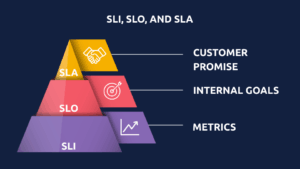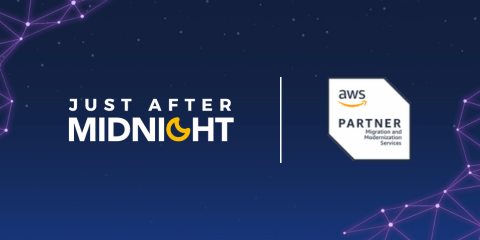Your SLA is a key part of your strategy. It’s a selling and reassurance point for new users. A part of your legal protection. And it’s what dictates your support and incident management strategy (whether in-house or outsourced) as well as key features of your environment.
In short, it’s worth getting right. And that’s exactly what we’ll help you do.
How would we know?
At Just After Midnight, our mission is to provide the best outsourced 24/7 full-stack support.
With teams of certified engineers across 4 time zones, a proprietary support platform, and an industry-leading, tech-enabled service, our mission since day one has been helping partners stay inside their SLAs.
We’ve worked with hyperscale SaaS products and leading agencies like Grey New York to ensure uptime, availability and resilience. Elevator pitch concluded.

Why is an SLA important – in detail
As a SaaS provider, an SLA has a number of business, operational and legal impacts. A good SLA means:
Faster deal closure
It shortens negotiation time and reassures prospective customers during the sales.
Reduced churn/more renewals
Customers who’ve had their SLA met and/or incidents managed are more likely to remain.
Cost and reputational protection
SLA breaches can be high-impact. Slack’s 2019 $8 million outages being a case in point. Safeguarding against such an eventuality pays for itself.
Operational efficiency
Sales, marketing and ops are aligned. Monitoring is defined. Service reviews are unambiguous. This helps everything tick along as intended.
…but a poorly constructed SLA leads to:
All the above points in the reverse
So, slow sales, reputation and revenue loss, increased churn and internal misalignment.
More breaches
One definition of a bad SLA is one that’s easy to breach. Here, you have whatever costs are incurred in the contract, plus the possibility of violating broader compliance law.
Support burnout and overspend – or the inverse
Without a defined SLA, support may be excessive. With forces marshalled on only slightly sub-par performance metrics. Or the support function flounders because it has no real goals.
Reliability falling short in infra planning
Without a clear SLA acting as a reliability or uptime mandate, other goals take over. Your team may end up optimising for cloud cost at the greater expense of reliability and revenue.
So, what qualities go into making a SaaS SLA that works for both providers and customers?
There are many practices to each of these points. But at the highest level, a good service level agreement for a SaaS provider is:
Achievable
Simple. You need to be able to do it. And what you need to be able to do must be…
Market competitive
In line with, or exceeding, the offers of your direct competitors.
Customer-centric
Aligned to the customer’s business and technology objectives, not just provider risk.
Transparent and attractive in a sales, marketing and technical context
If it’s an achievable, market-leading SLA, your customers and potential customers need to be able to grasp this. And your technical team need to be on the same page.
Flexible & future-proof with business growth
Structured to evolve alongside your product and customer base, without needing constant renegotiation.
Legally enforceable
All the above is moot if it doesn’t hold up legally.
So, how do these qualities show up in a good SLA?
Core Components of a SaaS Service Level Agreement
Agreement Overview
Rationale
Frames the SLA between provider and customer, tying it to the main subscription. First page procurement reads.
How the qualities show up
Transparent and attractive: One-screen executive snapshot (product, uptime %, credit trigger, support tier link) with clear cross-references so readers instantly see what applies.
Service Scope
Rationale
Defines the production application covered and lists broad exclusions (beta, sandbox, third-party software).
How the qualities show up
Market competitive: Cover commonly expected environments (e.g., production + staging); list exclusions up front; highlight differentiators against peers.
Service Levels & Metrics (incl. SLIs/SLOs)
Rationale
Publishes service performance targets: monthly service availability %, reliability goals, response windows, and scheduled maintenance periods.
How the qualities show up
Achievable: Set targets from trailing data; define each SLI/SLO precisely (formula, time zone, data source, exclusions). Place the downtime formula directly beneath the availability target to avoid ambiguity.
Support & Management
Rationale
Sets support hours, channels, escalation paths; your end-to-end service management process.
How the qualities show up
Customer-centric: Define severities by customer impact (e.g., ‘materially impairs production transactions’) and commit to first-response + workaround/engineering-engagement targets to minimise business disruption.
Customer Responsibilities
Rationale
Outlines what the customer must do to keep the SLA valid (e.g., supported browsers, named admin contacts).
How the qualities show up
Legally enforceable: Remedies pause while material responsibilities aren’t met; require a named admin for notices so obligations can be actioned.
Service Credits & Remedies
Rationale
Explains when service credits trigger, how they’re calculated, and the cap.
How the qualities show up
Legally enforceable: Credits auto-apply, include a clear monthly cap, and are the sole and exclusive monetary remedy; include a worked example to show trigger and calculation.
Data Security & Compliance
Rationale
Summarises encryption, certifications, and breach-notice timelines.
How the qualities show up
Market competitive: Reference widely recognised attestations (e.g., SOC 2/ISO) and access path to current reports; align incident/breach notice timelines to applicable law/DPA.
Contract Management & Termination
Rationale
Covers review cadence, amendment workflow, cure periods, and exit assistance.
How the qualities show up
Flexible with business growth: Commit to a review cadence (e.g., quarterly metrics review) and a one-page addendum path for changes; keep notice/cure periods visible.
Complete SaaS SLA template
Now, we’re combining what we’ve learned so far into a usable SaaS SLA template. However, it’s worth noting that:
- All exact figures given below are examples only; these numbers might vary greatly depending on client and product
- This is not a complete, legally binding contract
Download the custom template here: Complete SaaS SLA Template
Need to brush up on your SLA terminology? Here’s what SLI, SLO, and SLA mean
These three concepts form a connected hierarchy that moves from measurement to objectives then to contractual agreements. If the above left you a little in the dark, brush up here.

Service level indicators (SLIs) – The measurements
SLIs are Service Level Indicators, metrics that are compared to the SLO and SLA. An SLI is a key metric used to determine whether or not the SLO is being met (Spendflo Cloudeagle)
Examples of SLIs:
- Actual uptime percentage (e.g., 99.97% last month)
- Average response time (e.g., 150ms for API calls)
- Error rate (e.g., 0.05% of requests failed)
- Throughput (e.g., 1,000 requests per second processed)
Service level objectives (SLOs) – the internal goals
SLOs are goals and targets used internally, setting the performance standards your engineering teams aim to achieve.
Examples of SLOs:
- Maintain 99.95% uptime
- Respond to API requests within 200ms
- Keep error rate below 0.1%
Service level agreements (SLAs) – the customer promise
SLAs are externally focused, typically between a service provider and a customer.
Examples of SLAs:
- We guarantee 99.9% uptime with service credits for breaches
- Support tickets will receive initial response within 4 hours
How they work together
SLAs provide a contractual foundation, SLOs establish performance objectives, and SLIs offer tangible metrics to measure success.
The flow:
- SLIs measure what’s actually happening
- SLOs define what should be happening internally (some teams publish externally)
- SLAs promise what will be delivered to customers
Best practice: your SLOs should typically be stricter than your SLAs to provide a buffer. For example, if your SLA promises 99.9% uptime, your internal SLO might target 99.95% uptime
If your SLA states that your public API endpoint will return a response time in 200ms for 99.9% of requests, then your SLO is most likely a 150ms target.
This creates a system where you’re measuring reality (SLI), aiming for internal excellence (SLO), and making external commitments (SLA) with built-in safety margins.
Now on to how to stay inside your SLA.
Six proven practices for staying inside your SLA
Build observability around contract metrics
Most monitoring stacks measure whatever’s easy; shift the focus to whatever your agreed-upon service levels actually track: latency, error rate, monthly service availability.
Stream those signals into one observability dashboard and alert at 80% of breach.
Example: the dashboard turns amber when any region is 5 minutes from missing a 99.9% target, giving ops time to reroute traffic. This alignment between tooling and contract terms is the cornerstone of modern SLA best practices.
Engineer platform resilience as a business feature
Treat uptime as a product, not a side-effect.
Active-active deployment across two cloud data centres, automatic fail-over for stateful stores, and autoscaling headroom of 30% turn regional blips into non-events.
These design choices keep services provided to customers stable and your service provider reputation intact.
Example: a zone failure in us-east-1 shifts traffic to eu-west-1 in under 40 seconds, preserving the month’s uptime guarantees.
Change management that protects production
Unplanned downtime usually hides in routine deployments.
Publish a rolling scheduled maintenance calendar, use blue-green releases, and script rollbacks that trigger when error rate > 2%. You’ll finish upgrades inside the window and avoid penalty-triggering service outages.
Example: a Friday release fails health checks; the script rolls back in 60 seconds and customers see no blip, one of many SLA examples your sales team can showcase.
Automate security gates in the DevSecOps pipeline
Emergency patches steal time straight from the SLA error budget. Embed static-analysis, dependency scans, and signed containers into CI/CD so insecure builds never reach prod.
Fewer hot-fixes mean fewer surprise restarts, tighter response windows, and higher customer satisfaction.
Example: a vulnerable library is blocked at merge time, sparing the team a weekend fix that would have eaten the monthly error budget.
Quarterly SLA & contract-management review
Every quarter, export raw telemetry, map it to the current service scope, and test against the numbers in your SaaS service level agreement template.
Over-delivering? Ratchet targets up to stay market-competitive. Struggling? Add capacity or renegotiate before contract termination looms.
This ritual links data to decisions and keeps every business unit aligned with long-term business processes.
Example: analysis shows P95 latency averaging 140 ms against a 250 ms promise, so product marketing turns the win into a case study while legal tightens next-year targets – proof that rigorous reviews can improve both the SLA and the story you tell buyers.
How we can help
At Just After Midnight, we’ve helped SaaS companies in the USA, Europe, and Asia keep within their SLAs and keep delivering.
Through a combination of managed services, our signature 24/7 support (tailored to hyperscale, mission-critical applications) and outsourced user queries for B2B SaaS applications, we make sure our partners stay on 24/7, 365.
Read more about our work responding to incidents and service requests in under 3 minutes for SaaS security platform Absolute Software or supporting an Apple App Store No. 1 launch in the UK.
Or, to find out how we could help you, just drop us a line. We’ll be there in no time.




